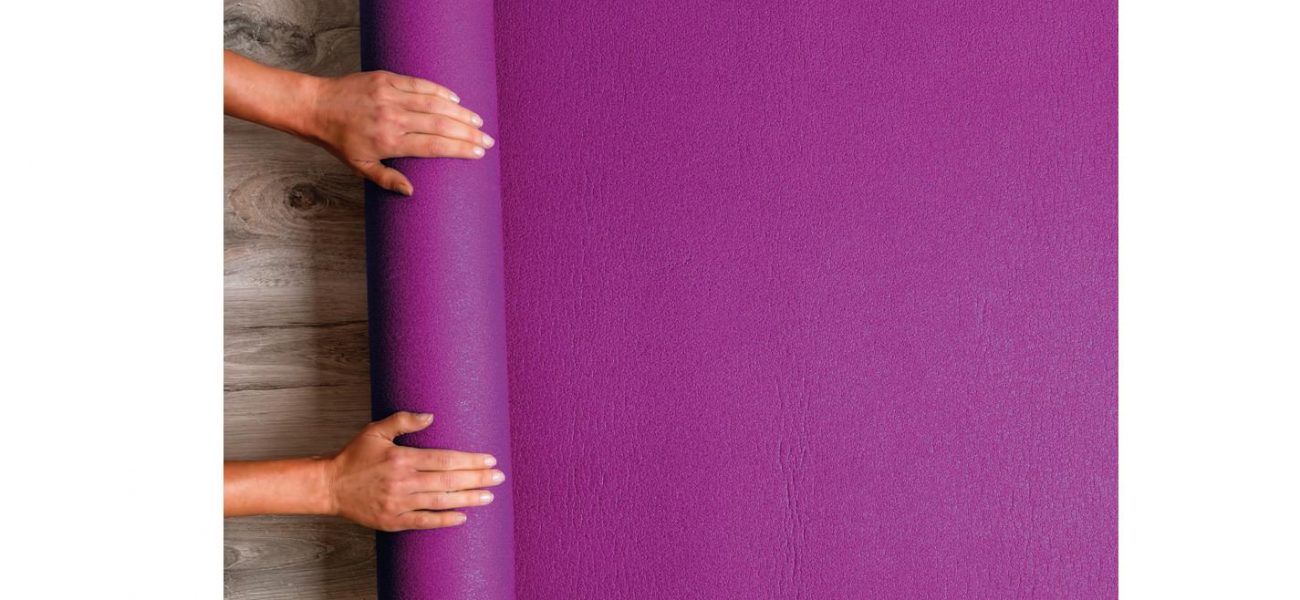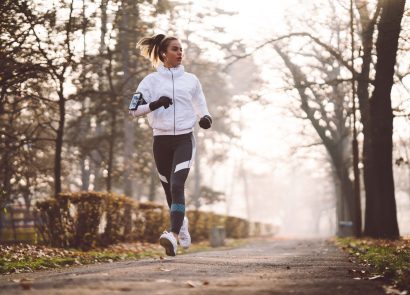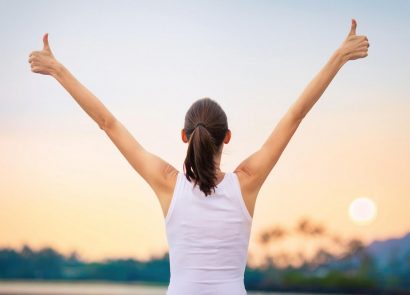Whether it’s a running sesh, a yoga class or simply playing with your kids – here’s the latest news and views on how to move more this month
How many of us have days when it all just seems too much? When we’re stressed, our body creates the stress hormone cortisol, our muscles tighten and get ready to burst in to action. If we stay in this stressed state, these natural responses can become a problem, but there are things you can do to get back into a state of calm, including yoga. This short sequence starts with deep breathing to relax your brain, and then moves on to yoga poses to calm and restore.
1. Easy pose (Sukhasana)

The best place to start for dealing with any type of stress or tension in the body is with your breath.
1. Bring yourself in to easy pose (a cross-legged position) by starting with your legs extended out in front of you, then crossing them at the shins. Think about lengthening up through the crown of your head to keep your spine long. Place one hand to your chest, the other to your belly, or rest your hands on your knees if it’s more comfortable.
2. Close your eyes and start to concentrate on your breath, start by simply noticing how you are breathing, whether it’s fast or slow, whether it’s in to your chest or all the way in to your stomach. Take this opportunity to check in with how you are feeling, both physically and mentally, without judgement. Starting from your head and working your way down the body, notice where you are feeling tension in your body. Focus on how you are feeling emotionally.
3. Next, start to breathe a little deeper, creating an even inhale and exhale – you can count in your head – inhaling for a slow count of three or four, then out for the same. Draw the breath all the way down to your tummy. If your hand is on your chest and stomach, you should feel it travel down past your chest to your tummy and then back up.
2. Cat and cow (Bitilasana marjaryasana)

The gentle movement with the breath brings your focus inward and gently warms through your spine, releasing any tension in your back.
1. Come forward onto your hands and knees with your fingers spread wide, your hands under your shoulders and your knees under your hips.
2. Moving with your breath, on your inhale drop your tummy and lift your sit bones and chest as you take your gaze up.
3. As you exhale, move slowly through your spine, rounding it up into cat pose, tucking your chin in as your gaze turns to your tummy, and gently draw your belly button in towards your spine. Squeeze your shoulder blades in towards each other.
4. Keep moving with your breath for five rounds of deep slow breath, then return to a neutral spine on your hands and knees.
3. Downward dog (Adho mukha shvanasana)

We can hold a lot of tension in our limbs if we are suffering with stress as our body prepares itself for the fight or flight response, so this move stretches through your hamstrings, legs and hips.
1. From a tabletop position on your hands and knees, spread your hands wide, with your middle fingers facing to the top of the mat.
2. Tuck your toes under and push your hips back to downward dog. Think about pressing your tummy towards your thighs, creating an upside down V shape and lengthening through your spine as you push your hips up and back.
3. Bend in to your knees as much as you need to be able to lengthen your spine.
4. Standing forward fold (Uttanasana)

Forward folds are considered restorative and calming poses, but also stretch through your hamstrings, legs and back, which are all places where we can hold tension in our body from stress.
1. From downward dog, bend your knees and slowly walk your feet towards your hands at the top of the mat. Step your feet a narrow hip-distance apart and let your body dangle down, keeping your spine long and again thinking about bringing your tummy in towards your thighs – your knees can be as bent as you need.
2. Imagine all of your worries and stress pouring out from the crown of your head.
3. On an inhale, slowly start to roll up to stand, stacking the vertebrae and finally bringing your head up last. Bend in to your knees as much as you need.
5. Mountain pose (Tadasana)

It may look simple, like you are simply standing up, but mountain pose is essential to setting your foundation for any standing poses. In addition to stretching through your legs and ankles, it focuses attention and posture and is a grounding pose.
1. Bring your big toes together with your heels slightly apart, or widen to hipdistance apart if needed. Think about keeping your spine long, but neutral, not over-tucking your tailbone, with the crown of your head reaching up.
2. Gently engage your thighs, then bring your hands beside you with your palms facing forward. Close your eyes and take five deep rounds of breath, bringing awareness to your feet and imagining grounding down evenly through your feet and setting your foundation.
6. Tree pose (Vrksasana)

Balancing poses are great for stress as they bring your focus inward as you need complete attention on your pose and breath.
1. From mountain pose, find a focus point on the floor or the wall and keep your gaze steady. Start to take the weight in to your left leg as you draw your right knee up to the chest. Rotate the knee out to the side and bring the sole of your right foot to your inner thigh or calf of the left leg (you can use your right hand to position your foot to your inner thigh). Any position on your leg is fine if you can’t get it all the way up towards your groin, but avoid pressing it directly on to the side of the knee of your standing leg.
2. Think about engaging your thigh muscle in your standing leg as if you were pulling your kneecap up to strengthen through the standing leg, and balance. Bring your hands to your heart in prayer, keeping them here or extending your arms up above you, keeping your palms pressing together and trying not to scrunch your shoulders up towards your ears.
3. Hold for five rounds of breath. Repeat on the other side.
7. Child’s pose (Balasana)

This is a deeply restorative and calming pose. If you’re in the wide legged version, you’re also stretching through your shoulders, which may feel tight or be holding tension when you’re stressed.
1. Bend in to your knees and bring yourself down to the floor to the centre of the mat on your hands and knees.
2. Take your knees wide and bring your big toes together behind you. Sit back towards your heels, and fold forward with your head on the floor. Draw your attention to the point between your brows, where your forehead is in contact with the mat. Feel free to bring your knees together and wrap your arms around behind you with your palms facing up if that’s more comfortable for you.
8. Legs up the wall (Viparita karani)

This is a deeply restorative pose, activating the parasympathetic nervous system, relieving stress and reversing blood flow back down the legs to the heart and upper body. If you only have five minutes to de-stress, this is the pose for you. It’s a passive pose, needing very little flexibility or strength.
1. If you have a wall space available, you can use it for this, sliding your mat so it’s up against it. If you don’t have one, then you can use a yoga block, bolster or a regular cushion or rolled up blanket to create a support for the base of your lower back. If you are by a wall, sit yourself next to it with your hip against it, before lying yourself down and bringing your legs up the wall. You may need to shuffle to get in to position – the closer you bring yourself to the wall, the stronger the stretch. If you have tight hamstrings, you might ease slightly way. If you are using a prop, lie on your mat and it to the edge of the buttock and lift your hips on to slightly elevate and extend the legs up. They do not have to be completely straight and don’t worry if they start to drop in closer towards you as you hold the pose.
2. Try to relax the shoulders and upper back down to the mat. Hold for at least five breaths, or several minutes if you have time.
3. To come out of the pose, bend your knees in towards you and ease out.
9. Corpse pose (Savasana)

This pose will give you time to soak in the benefits of your practice and allow your body to fully relax.
1. Come away from the wall or gently lift your hips to remove any props, then lie on your back with your legs extended and your feet out towards the outer corners of the mat for the final resting pose. Let your arms rest beside you, slightly away from your body with your palms facing up. Allow yourself take up some space and let your breath settle in to its natural pattern.
2. Close your eyes, soften your jaw and scan from the top of your head down like you did at the start, relaxing everything that you can and allowing yourself to feel heavy on the mat.
3. Come out slowly, starting with a little movement to your fingers and toes, rolling your head from side to side, moving on to circling your wrists and ankles and then taking a big, full-body stretch before rolling on to your side and easing yourself back up to a seated position from there, keeping your eyes closed if possible.
4. Bring your hands into prayer position at your heart, drawing attention to your heart and noticing if there has been any change to how you are feeling from the start of your practice. Take a deep breath in through your nose and out of your mouth. Gently blink your eyes open.
Michelle Taylor is a yoga teacher, reiki healer and holistic coach based in Surrey (livehappylivehealthy.co.uk).




















